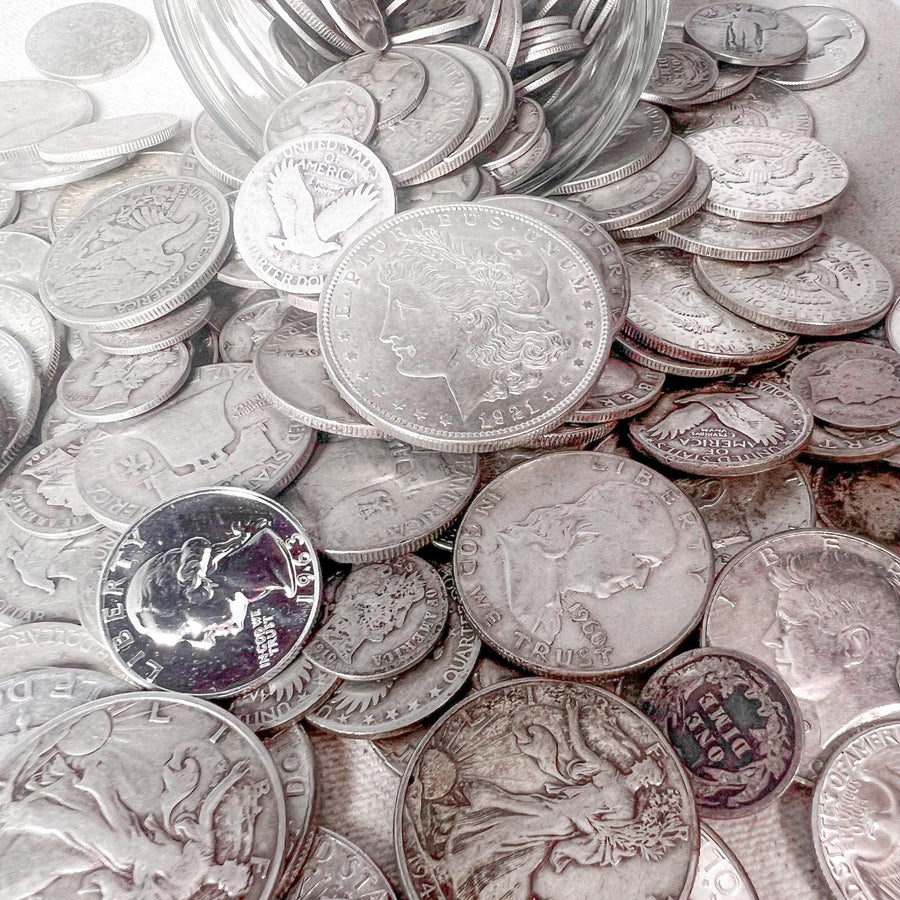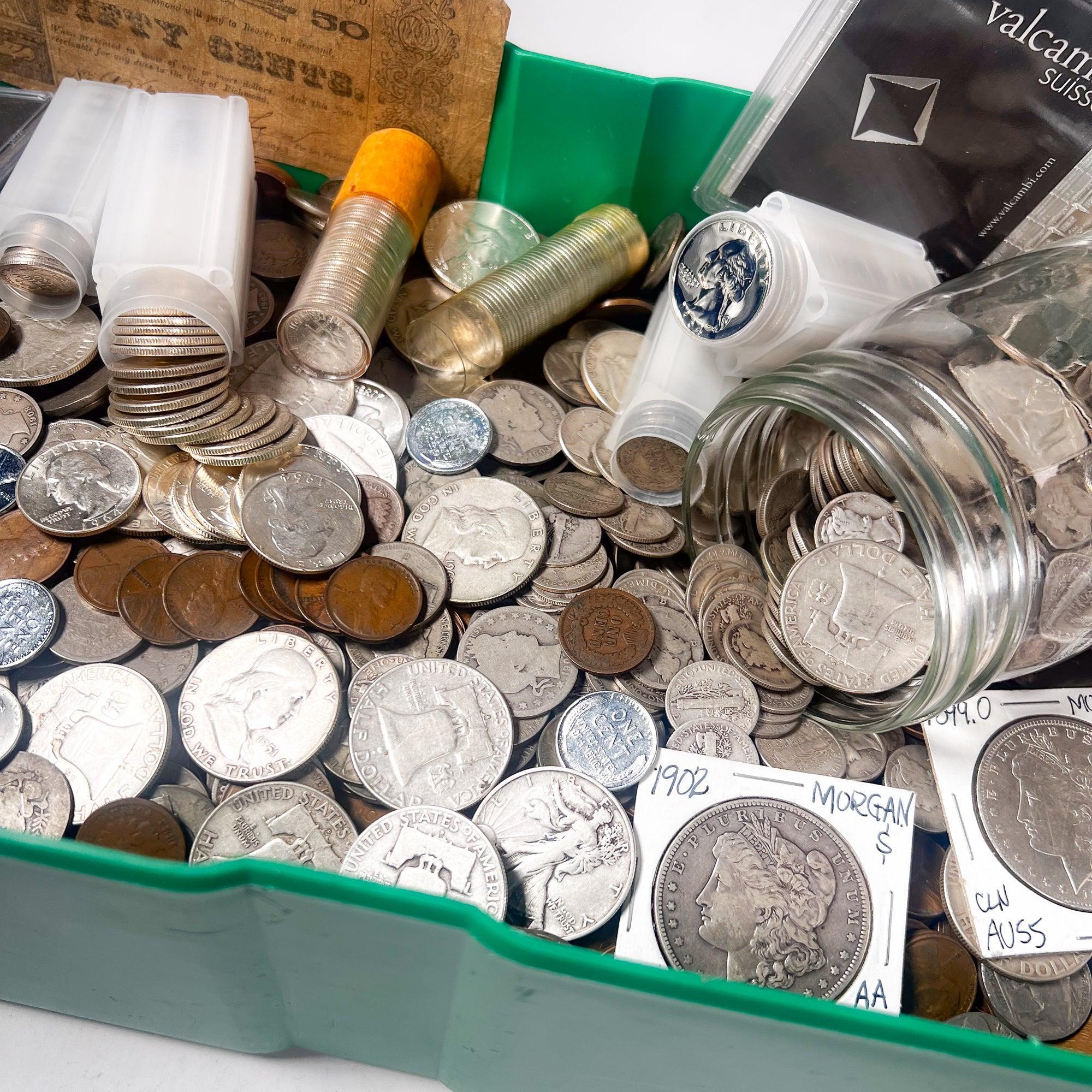The Definitive Guide to Avoiding Common Mistakes When Collecting Silver Dollars
The allure of collecting U.S. silver dollars is undeniable, drawing enthusiasts into a rich tapestry of American history, artistry, and tangible value. Yet, for many aspiring collectors, this pursuit can be fraught with apprehension.
The digital age, while offering unprecedented access, also presents significant challenges, particularly the pervasive fear of encountering counterfeit or misrepresented items. The difficulty in discerning reputable sources and authenticating rare U.S. coins can deter even the most passionate individuals.
This comprehensive guide is meticulously crafted to address these critical concerns, providing a clear pathway for avoiding mistakes collecting silver dollars and ensuring your journey is built upon a foundation of knowledge, integrity, and genuine acquisition.
The Enduring Appeal and Inherent Risks of Collecting U.S. Silver Dollars
The fascination with valuable U.S. silver coins stems from a unique confluence of historical significance, artistic merit, and intrinsic precious metal content. These coins are not merely monetary instruments. They are artifacts, encapsulating moments of American heritage and economic evolution.
Historical Significance and Numismatic Value
U.S. silver dollars, such as the iconic Morgan dollars (1878-1921) and the elegant Peace dollars (1921-1935), represent pivotal eras in American history. The Morgan dollar, born from the Comstock Lode silver discoveries, symbolized the nation's expansion and industrial might, circulating widely across the burgeoning West. Its successor, the Peace dollar, was minted to commemorate the end of World War I, its design embodying hope and tranquility.
Beyond their historical narratives, these coins possess significant cultural appeal. Each strike is a testament to the era's craftsmanship and artistic sensibilities. For numismatists, the intersection of their substantial precious metals content with their numismatic rarity transforms them into highly sought-after collectibles, appreciated for both their silver weight and their historical premium.
Defining a Valuable U.S. Silver Dollar Collection
What truly defines a valuable collection of U.S. silver dollars extends beyond mere quantity. It encompasses a rigorous assessment of each coin's unique characteristics. A coin's market value is determined by its scarcity, condition, and desirability among collectors. It is crucial to understand the nuanced distinction between a coin's intrinsic metal value, which fluctuates with the global price of silver, and its collector premium.
The collector premium is influenced by factors such as mintage figures, surviving population reports, historical context, and the coin's aesthetic appeal and strike quality. This premium often far exceeds its melt value.
The Lure of Acquisition and the Imperative of Caution
The pursuit of acquiring exceptional silver dollars is a profound experience for many collectors, driven by a desire to connect with history and possess tangible assets. However, this fervent desire must be tempered with an acute awareness of the common challenges and potential pitfalls inherent in the numismatic market. The appeal of adding a rare date or a high-grade example to one's collection can, at times, overshadow the imperative for diligent research and verification. It is precisely in this delicate balance that the need for informed decision-making becomes paramount, ensuring that passion is guided by prudence.
Common Pitfalls for Silver Dollar Collectors: Avoiding Mistakes When Collecting Silver Dollars
Navigating the complex world of numismatics requires a sharp eye and a disciplined approach, especially when avoiding mistakes collecting silver dollars. Many pitfalls, ranging from misjudging condition to outright purchasing counterfeits, can lead to significant financial losses and erode the pleasure of collecting. Understanding these common errors is the first crucial step toward building a secure and valuable portfolio.
Misidentifying Coin Grades and Values
Accurate coin grading is the cornerstone of numismatic valuation. Misidentifying a coin's grade is one of the most frequent and costly errors collectors make.
The Subjectivity versus Objectivity of Grading
Coin condition profoundly impacts its market value. While professional coin grading aims for objectivity, relying on standardized scales and criteria, amateur assessment often injects subjectivity. This leads to common errors such as overgrading, believing a coin is in better condition than it truly is, or overlooking subtle flaws that significantly devalue a piece. A critical distinction lies between "circulated" coins, which show signs of wear from handling, and "uncirculated" or Mint State coins, which retain their original luster and detail. Understanding these differences, particularly the nuances that separate an AU (About Uncirculated) from an MS (Mint State) grade, is essential for informed collecting.
Factors Influencing Market Valuation
The market value of a silver dollar is a complex interplay of several key factors. Rarity, primarily dictated by original mintage figures and the coin's surviving population, is fundamental. Condition, as determined by its assigned grade, eye appeal, and strike quality, dictates the premium a collector is willing to pay. Furthermore, historical context and a verifiable provenance can also add substantial value, transforming a common date into a noteworthy acquisition.
Overlooking Authenticity Markers and Alterations
Beyond grade, the originality and authenticity of a coin's surfaces are paramount. Many errors occur when collectors fail to distinguish natural wear from detrimental alterations.
Signs of Post-Mint Damage versus Mint Errors
It is crucial to differentiate between Post-Mint Damage (PMD), which occurs after a coin leaves the U.S. Mint, and legitimate Mint Errors. Mint errors are anomalies created during the manufacturing process and can add significant value. PMD can include scratches, dings, excessive cleaning, or environmental damage, all of which diminish a coin's appeal and market value. Common alterations designed to deceive include artificial re-toning, which attempts to mimic natural patina, or the removal of scratches through abrasive methods. Recognizing these alterations is critical for silver dollar authentication tips.
The Nuance of Originality
The preservation of original surfaces and natural toning is paramount for a coin's long-term value. Natural toning, developed over decades, often enhances a coin's aesthetic appeal and indicates its undisturbed state. Conversely, any form of cleaning, polishing, or harsh handling irreversibly alters the coin's original surface. This significantly diminishes its numismatic appeal and market worth, even if the intent was to "improve" its appearance. A cleaned coin is considered a damaged coin in the eyes of experienced numismatists.
Falling for Counterfeit Coins and Forgeries
Perhaps the most insidious pitfall is acquiring a counterfeit. The threat of acquiring identifying fake silver dollars is a growing concern in the numismatic community, necessitating vigilance and specialized knowledge.
The Growing Threat of Counterfeiting
The market is increasingly infiltrated by sophisticated counterfeit U.S. silver dollars, making identifying fake silver dollars a crucial skill. These fakes range from crudely cast copies to highly deceptive pieces designed to mimic genuine issues. Specific examples include modern Chinese counterfeits that target popular series like Morgan dollars and Peace dollars, altered dates designed to create rare varieties, and entirely fabricated "error" coins. These forgeries often leverage advanced manufacturing techniques, making their detection challenging for the untrained eye.
Initial Red Flags for Identifying Fake Silver Dollars
Several initial red flags can indicate a counterfeit. Genuine silver dollars possess a distinctive luster and texture. Unusual shininess, a dull appearance, or a gritty feel can be warning signs. Incorrect weight or dimensions are common indicators, as counterfeiters often struggle to replicate the precise specifications of genuine issues due to differences in metal composition or manufacturing processes. Poor strike details, mushy design elements, or inconsistencies in the reeding, the grooves on the coin's edge, are also critical clues. Examining the edge, especially for differences in how the reeding meets the rim, can be a potent silver dollar authentication tip.
Advanced Counterfeit Detection Techniques
For more advanced counterfeit detection, magnification is indispensable. Close examination under a loupe can reveal discrepancies in die characteristics, tool marks not present on genuine coins, or evidence of casting seams. Understanding known diagnostics for specific genuine issues, such as specific die varieties (VAMs for Morgan dollars), can help distinguish authentic coins from altered ones. Furthermore, the role of magnetic properties (true silver is non-magnetic, while many fakes contain magnetic base metals) and metallic composition analysis (e.g., specific gravity tests) provides an objective means of verification for robust counterfeit detection.
Poor Preservation and Storage Practices
Even an authentic and valuable coin can lose its integrity and worth if not properly preserved. Neglecting proper storage is a common mistake that diminishes a collection's value over time.
Environmental Hazards to Silver Coins
Silver coins are susceptible to a range of environmental hazards. High humidity and extreme temperature fluctuations can accelerate oxidation, leading to unsightly toning or even irreversible corrosion. Atmospheric contaminants, such as sulfur-containing gases, are notorious for causing unattractive toning patterns or, in severe cases, pitting the coin's surface. A stable, controlled environment is paramount for long-term coin preservation.
Inadequate Storage Materials
The choice of storage materials is critically important. Many common coin holders, particularly those made from PVC (polyvinyl chloride), release plasticizers over time that can react with a coin's surface. This causes a slimy, green residue that permanently damages the metal. Similarly, improper handling, such as touching coin surfaces directly with bare fingers, transfers skin oils and contaminants that can lead to permanent blemishes and discoloration.
The Cost of Neglect
The cost of neglect in coin preservation is often irreversible. Improper storage can permanently diminish a coin's condition and, consequently, its market value. A coin that once held a high grade and significant premium can be downgraded substantially due to preventable environmental damage or improper handling, illustrating the tangible impact of seemingly minor oversights.
Impulsive Purchases and Lack of Strategic Research
Hasty decisions driven by emotion rather than informed analysis represent another significant pitfall for collectors.
The Dangers of Hasty Decisions
Buying under pressure or without sufficient knowledge can lead to profound regrets. This often manifests as overpaying for misrepresented coins, acquiring pieces with undisclosed flaws, or even purchasing counterfeits due to a lack of due diligence. The allure of a seemingly "good deal" can be a powerful motivator. Yet, it is precisely in these moments that caution is most required for a sound investment strategy.
Absence of a Defined Collection Strategy
Many collectors start without a clear goal or understanding of market trends. This often leads to a haphazard collection rather than a cohesive, valuable one. Failing to focus on specific series, such as a complete set of Morgan dollars by mint mark, particular grades, or types of silver dollars can result in a fragmented collection that lacks overall market appeal and liquidity. A well-defined strategy guides purchasing decisions and ensures each acquisition contributes meaningfully to the collection's long-term value.
Essential Strategies for Informed Silver Dollar Collection
Building a robust and authentic collection of valuable U.S. silver coins is an endeavor that rewards diligence, knowledge, and a commitment to best practices. By adopting proven strategies, collectors can confidently navigate the market and protect their investments.
Mastering Grading and Professional Certification
A fundamental understanding of numismatic coin grading standards is indispensable for any serious collector.
Understanding the Numismatic Grading Scale
The Sheldon Scale, ranging from 1 (Poor) to 70 (Perfect Mint State), provides a standardized framework for evaluating a coin's condition. Collectors must understand the key attributes defining each grade level, from Proof (PR) and Mint State (MS) for uncirculated coins, down through About Uncirculated (AU), Extremely Fine (XF), Very Fine (VF), Fine (F), and Good (G) for circulated pieces. This involves discerning the level of wear, the presence of original luster, the sharpness of design details, and the overall eye appeal. Mastering this scale empowers collectors to accurately assess potential acquisitions.
The Indispensable Role of Third-Party Grading Services
For all but the most casual collecting, professional authentication and grading by reputable third-party services is indispensable. Companies like NGC (Numismatic Guaranty Company) and PCGS (Professional Coin Grading Service) provide an unbiased, expert assessment. They encapsulate coins in sealed, tamper-evident holders known as "slabs." Slabbed coins offer unparalleled security, enhance liquidity by providing undisputed authenticity and grade, and serve as a universally accepted benchmark in the market. Understanding how to interpret grading labels, including any sub-grades or designations such as "DMPL" (Deep Mirror Prooflike) or "Full Head" for Peace dollars, is crucial for assessing their premium market value.
Verifying Provenance and Authenticity
The ability to verify a coin's authenticity is paramount, protecting collectors from counterfeits and altered pieces.
Implementing Silver Dollar Authentication Tips
A comprehensive checklist for evaluating a coin's genuineness is a critical tool for silver dollar authentication tips. This involves meticulously examining mint marks, dates, and design elements for consistency with known genuine examples. Leveraging known historical information, such as the unique characteristics of GSA Hoard Morgan dollars, which often come in distinctive hard plastic holders, can provide powerful authentication clues. Understanding the specific die varieties and their characteristics can often distinguish genuine, unaltered coins from those that have been manipulated.
Utilizing Advanced Authentication Tools and Resources
Collectors should utilize advanced authentication tools and resources. High-resolution imaging, allowing for detailed comparison to known genuine examples, is a powerful technique. Consulting reputable numismatic references, such as the Red Book (A Guide Book of United States Coins) and online databases maintained by NGC and PCGS, provides essential information on mintage figures, known diagnostics, and market values. Furthermore, seeking second opinions from accredited professionals or respected numismatists adds an additional layer of security, especially for high-value acquisitions.
The Importance of Reputable Dealers and Expert Consultation
Choosing the right partners in your numismatic journey is as important as the coins themselves.
Criteria for Selecting a Trustworthy Numismatic Dealer
The selection of a trustworthy numismatic dealer is a decision that demands careful consideration. Look for dealers with professional affiliations and industry credentials, demonstrating their commitment to ethical practices. Years of experience and specialized knowledge in valuable U.S. silver coins, particularly silver dollars, ensure they can offer informed guidance. Transparent business practices, including fair return policies and clear, accurate coin descriptions, are hallmarks of integrity. Crucially, a positive dealer reputation within the numismatic community, often reflected in testimonials and long-standing relationships with clients, signals reliability.
Leveraging Expert Knowledge
The benefits of seeking advice from experienced numismatists cannot be overstated. Their deep knowledge mitigates risks by helping collectors avoid common pitfalls and make sound acquisition decisions. Our company, for instance, is built upon a foundation of unwavering dedication to offering genuinely authenticated U.S. silver dollars. We pride ourselves on our expertise in numismatics, serving as a trusted partner in building valuable collections through rigorous authentication and transparent dealings. Our commitment is to provide the trusted, knowledgeable source that collectors seek.
Proper Preservation and Storage Techniques
Protecting your collection from environmental damage and physical harm is a continuous responsibility that safeguards its value.
Best Practices for Long-Term Coin Preservation
For long-term coin preservation, using inert, archival-safe holders is paramount. This includes Mylar flips, non-PVC capsules, or professionally slabbed coins from NGC or PCGS. These materials prevent harmful chemical reactions with the coin's surface. Storing coins in a stable, climate-controlled environment, ideally with consistent temperature and humidity levels, protects against environmental degradation. Implementing a secure storage solution, such as a safe or bank vault, is essential to protect against theft and physical damage, ensuring the collection's physical and financial integrity.
Safe Handling Procedures
Safe handling procedures are simple yet critical. Always hold coins by their edges to avoid transferring oils and contaminants from your skin to the coin's surfaces. Wearing lint-free cotton gloves provides an additional layer of protection. Crucially, avoid any form of cleaning or alteration. What may appear as tarnish or dirt is often natural patina, which is highly valued by numismatists. Cleaning a coin, even gently, will remove this original surface, severely diminishing its numismatic value.
Strategic Acquisition: Research Before You Buy
Informed decision-making is the bedrock of a successful collection, necessitating thorough research before any purchase.
In-Depth Market Research and Price Analysis
Before acquiring any silver dollar, conduct in-depth market research and price analysis. Consult reputable price guides, review recent auction results, and analyze market trends to understand the current market value of specific issues and grades. Recognize that if a deal appears "too good to be true," it almost invariably is, signaling potential misrepresentation or a counterfeit. This diligent preparation prevents overpaying and ensures that acquisitions are made at fair market value, aligning with a sound investment strategy.
Developing a Focused Collection Strategy
A focused collection strategy provides direction and purpose to your acquisitions. Define clear collection goals, whether it is completing a specific series, such as a date and mint mark set of Peace dollars, collecting coins in particular grades, or focusing on rare varieties. Prioritize purchases based on your budget, the rarity of the coin, and your personal interest. A strategic approach transforms disparate purchases into a cohesive, valuable, and personally rewarding collection.
Building a Resilient and Authentic Silver Dollar Portfolio
The journey of collecting valuable U.S. silver coins is an ongoing commitment to learning, vigilance, and trust. By consistently applying the principles of informed collecting, you can build a resilient and authentic silver dollar portfolio that appreciates in value and provides enduring satisfaction.
Sustaining Value Through Vigilance and Continuous Learning
The numismatic market is dynamic, and sustained value requires ongoing engagement and education.
Ongoing Education in Numismatics
Collectors must commit to ongoing education in numismatics. Staying abreast of market changes, new discoveries (such as previously unknown die varieties), and evolving authentication techniques is crucial. Participating in numismatic forums, attending coin shows, and engaging in educational events can broaden your knowledge base and connect you with a community of shared expertise, further enhancing your ability for avoiding mistakes collecting silver dollars.
Regular Review and Maintenance of Your Collection
Periodically inspecting coins for any signs of degradation or improper storage is a critical maintenance task. This proactive approach allows for early detection of issues before they cause irreversible damage. Additionally, regularly updating insurance policies to reflect current market values ensures that your valuable assets are adequately protected against unforeseen circumstances.
The Enduring Role of Trust and Expertise in Numismatics
The core principles of collecting—authenticity, security, and fair dealings—remain the bedrock of a successful numismatic experience.
Reaffirming the Core Principles of Collecting
Diligent research, thorough authenticity verification, and choosing reputable dealers are paramount to building a valuable and authentic silver dollar collection and avoiding costly errors. These principles safeguard your investment and ensure that each acquisition truly contributes to the integrity and worth of your collection. Trust in the authenticity of your coins and the integrity of your sources is not merely a preference. It is a necessity.
Our Commitment to Integrity and Client Confidence
At our core, we understand that trust is earned through consistent adherence to the highest standards. We are unwavering in our dedication to offering genuinely authenticated U.S. silver dollars, underpinned by rigorous verification processes and deep numismatic expertise. Our role extends beyond transactions. We are committed to being a trusted partner in your collecting journey, providing the knowledge and security necessary for you to confidently build a valuable and authentic portfolio of valuable U.S. silver coins. We strive to eliminate the fear of purchasing misrepresented items by providing transparent, expert-vetted offerings.
Explore our authenticated collection of vintage U.S. coins and silver dollars to start or enhance your secure investment.
Frequently Asked Questions
How can I identify a fake silver dollar?
Look for discrepancies in luster, texture, weight, and dimensions compared to genuine coins. Examine strike details, design elements, and the reeding on the edge for inconsistencies. Advanced methods include magnetic testing and examining die characteristics under magnification.
What are the most important silver dollar authentication tips?
Always compare your coin to known genuine examples, consult reputable numismatic references, and look for specific diagnostics related to mint marks and die varieties. Consider using professional third-party grading services like NGC or PCGS for verification, especially for valuable pieces.
Why is professional coin grading important for silver dollars?
Professional coin grading provides an unbiased, expert assessment of a coin's condition and authenticity. Services like NGC and PCGS encapsulate coins in sealed holders, ensuring their grade and genuineness are universally accepted. This enhances liquidity and protects your investment.
How should I properly store my silver dollar collection?
Store silver dollars in inert, archival-safe holders such as Mylar flips, non-PVC capsules, or professional slabs. Maintain a stable, climate-controlled environment to prevent environmental damage. Always handle coins by their edges, preferably with lint-free cotton gloves, and never attempt to clean them.
What are the key factors that determine a silver dollar's market value?
A silver dollar's market value is determined by its rarity (mintage figures and surviving population), its condition (professional grade and eye appeal), and its historical context. Its intrinsic precious metal content also contributes, but numismatic factors often command a higher premium.
P.S. Ready to get started collecting silver dollars? Check out some of what MWPMX has to offer!












